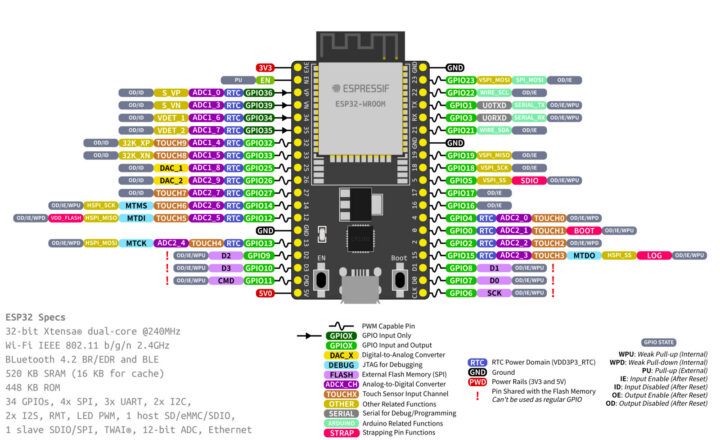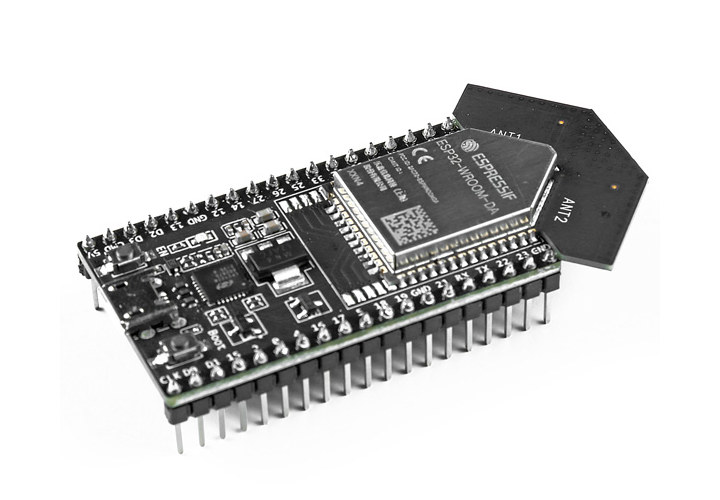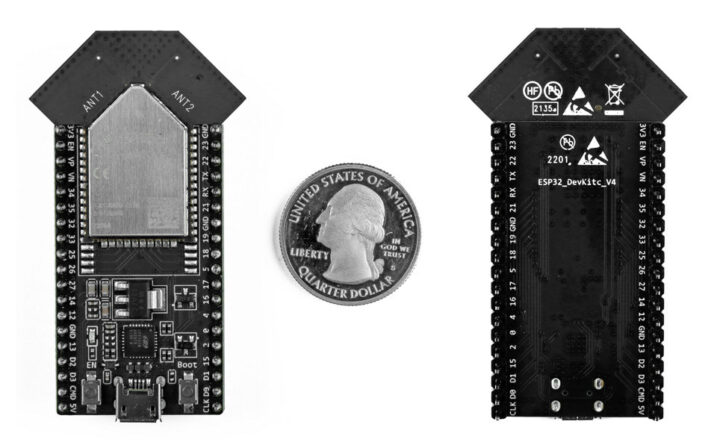The ESP32 DevKitC V4 is now selling with the ESP32-WROOM-DA module with two PCB antennas that was introduced last year in order to offer a longer WiFi range and better reliability.
The development kit is exactly the same as the other ESP32 DevKitC V4 models, and the only difference is the dual antenna design. When running a recent version of the Arduino Core for the ESP32 (2.0.3 or greater), the ESP32 will automatically switch to the antenna with the strongest signal in order to deliver the best connectivity possible.
ESP32 DevKitC V4 specifications:
- Wireless module – ESP32-WROOM-DA (PDF datasheet) with
- SoC – Espressif Systems ESP32-D0WD-V3 dual-core LX6 microprocessor with 520 KB SRAM, 2.4 GHz WiFi 4 and Bluetooth 4.1 connectivity
- Storage – 4MB SPI flash
- Two PCB antennas (ANT1 and ANT2)
- USB – 1x Micro USB port for power, programming, and debugging through USB-to-UART bridge up to 3 Mbps
- Expansion – 2x 18-pin headers with up to 34x GPIO, PWM, 12-bit ADC, DAC, 3x I2C, 4x UART, I2S, 4x SPI, etc…
- Misc – Reset (EN) and Boot buttons, Power LED.
- Power Supply – 5V via micro USB port, 5V or 3.3V via header; note: all three methods are mutually exclusive
- Dimensions – It’s complicated, but the main board measures 48.2 x 27.9 mm
You’ll notice the antenna design has changed since the first announcement with a “T” design replacing the “Snake” design that looks great on T-shirts, but I suppose there was a good reason for the change. You’ll find the documentation to get started with the ESP-IDF framework on Espressif’s documentation website.
Sparkfun notes that “not all pins are broken out and some have more than one role” and specifically “the pins D0, D1, D2, D3, CMD and CLK are used internally for communication between ESP32 and SPI flash memory”, so you should avoid using those. It’s the same story for all ESP32 DevKitC V4 variants.

You can check out the WiFiScanDualAntenna.ino sketch to test antenna switching. Andreas Spiess tested the ESP32-WROOM-DA module last April and found the dual antenna module does perform better than the single antenna modules and noted a good antenna design may even help lower the power consumption.
Sparkfun is selling the ESP DevKitC V4 development board with ESP32-WROOM-DA for $14.95, or you could also get the module only for $5.95. If you live outside the US, you should also be able to purchase from a local distributor to lower the shipping fee, and potentially avoid extra paperwork to comply with US export requirements.
As a side note, the Espressif DevConf 2022 will take place on October 19-20, and anybody interested can register for free.
Via ThaiEasyElec (which sells the module in Thailand for 790 THB)

Jean-Luc started CNX Software in 2010 as a part-time endeavor, before quitting his job as a software engineering manager, and starting to write daily news, and reviews full time later in 2011.
Support CNX Software! Donate via cryptocurrencies, become a Patron on Patreon, or purchase goods on Amazon or Aliexpress






